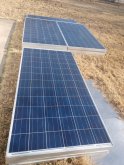jasonhc73
Cat herder, and dog toy tosser.
Jason: thanks for this very timely posting. I have just finished with 14 hours of charging my first cycle on my BYD battery and my anxiety level if high trying to figure out what I did wrong. I charged my one BYD test battery at 10 amps with a cutoff voltage of 3.55 per cell. It went overnight and I found it stopped out in the morning. The thing that caused my anxiety to go high is that the shunt only recorded 1.15 KwH and 40 Ah accumulation in the battery. I then reduced the amps to only 5 amps and increased the cutoff voltage on my balancing charge controller to 3.6 v per cell. It got there in 30 min more with final reading of 1.18 KwH and 44.5 Ah. Thats only 26% of the expected capacity of 4.5 KwH and 160 Ah. So I freaked out wondering what went wrong. The current settled voltage is 26.76 or 3.34 per cell.
What was your capacity for your batteries? If you could put it in terms of a single BYD expected battery capacity of 4.5 KwH that would be helpful.
I am planning to let the battery rest for a day or two and then discharge it again down to about 2.8 v per cell and recharge for my second cycle. Any suggestions and ideas?
The only way to know how much kWh the battery has is to use it and just let it cycle down to where ever you want it to be.
I run my entire house with everything going normal, no saving nothing for 6+ hours a day 5 days a week. Starting today at 52.2V and ending at 51.0V. The "SOC", went from 89% to 85% in today's 6 hours of usage.
Relax, they are very high quality, designed for utility grade or public transit use. BYD doesn't fool around. One of my packs is dated 2012. Think about that.
Why spend all this effort "testing", they work, just use them.
I keep my batteries in the 95% to 20% cozy comfy range:

Click the link in my signature.
Last edited:





